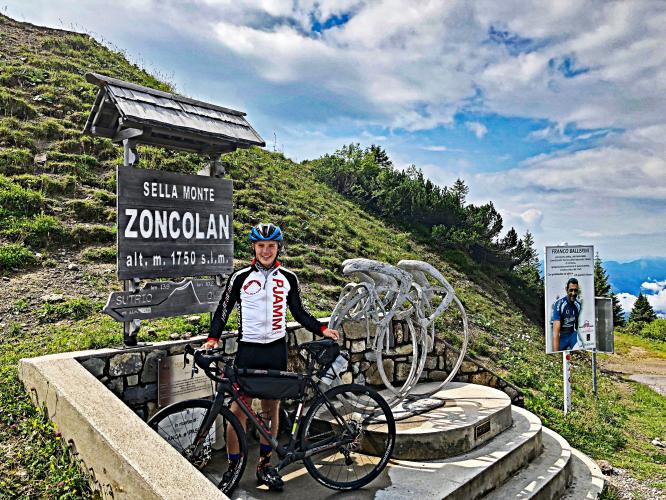
INTRO
PLAN YOUR ROUTE
 We've partnered with Sherpa-Map.com to bring you the best route planning tool. With a PRO Membership you can use this climb as a reference when creating your route.
We've partnered with Sherpa-Map.com to bring you the best route planning tool. With a PRO Membership you can use this climb as a reference when creating your route. ROUTE MAP



 We've partnered with Sherpa-Map.com to bring you the best route planning tool. With a PRO Membership you can use this climb as a reference when creating your route.
We've partnered with Sherpa-Map.com to bring you the best route planning tool. With a PRO Membership you can use this climb as a reference when creating your route. 
Cycling Monte Zoncolan from Priola
Ride a mere 8.7 kilometers gaining 1,103 meters at a torturous 12.8% average grade.
Cycling Monte Zoncolan from Priola is the least cycled and hardest route to the top. This is the “Old Road” and it is all of that. Very narrow and secluded, this is an exceptional cycling experience. If you are riding from Ovaro up and over the top and then down to Priola, be very careful not to miss the right turn precisely 3.3 km from the top (just after Rifugio Al Cocul). If you make it to the main ski area and SP 123 you missed the turn! (as we did in 2016).
2021 GIRO D’ITALIA
PJAMM CYCLING’S 2021 GIRO PAGE
After a 2 year hiatus, the Giro d’Italia returns to Monte Zoncolan May 22, 2021 for a Stage 14 mountain top finish. However, while the traditional route up Zoncolan is from Ovaro, the Giro features the mountain from the Sutrio side in 2021. The Giro has never featured Monte Zoncolan from Priola.
Below is a table from Wikipedia showing the Giro d’Italia 6 prior appearances for Monte Zoncolan in the Giro:
Year | Stage | Winner | Side |
2003 | 12 | Gilberto Simoni (ITA) | Sutrio |
2007 | 17 | Gilberto Simoni (ITA) | Ovaro |
2010 | 15 | Ivan Basso (ITA) | Ovaro |
2011 | 14 | Igor Antón (ESP) | Ovaro |
2014 | 20 | Michael Rogers (AUS) | Ovaro |
2018 | 14 | Chris Froome (GBR) | Ovaro |
“This is the original old road which was replaced by the newer road from Sutrio described above. The two roads combine around 4 kilometres (2.5 mi) below the summit. The road from Priola was first asphalted in autumn 2005. From bottom to top, the 8.9 kilometres (5.5 mi) long road gains an astonishing 1,140 metres (3,740 ft), meaning an average gradient of 12.8%. The lower part has sharp hairpin bends and is at times very steep. The climb is briefly flat after merging with the newer road, with the remaining 3.5 kilometres (2.2 mi) containing several ramps of up to 23% steepness.”
View back towards Priola with Dolomites in the background - Priola climb
If you are in the area, be sure to climb Monte Zoncolan from Ovaro, its more popular and famous side.
Below are all of the kilometer signs on the Monte Zoncolan from Ovaro climb. If a year for a Grand Tour is listed, that means the rider won the event that year, unless specified otherwise (e.g., if he was KOM).
Ottavio Bottecchia (IT; Winner TdF 1924-1925); Alfredo Binda (IT; Giro d’Italia 1925, 1926, 1928-1929, 1933; World Road Race Champion 1927, 1930, 1932).
Photos clockwise from top left: Louison Bobet (FR; TdF 1953-1955); Charly Gaul (LU; Giro 1956, 1959, KOM 1956, 1959;; TdF 1958, KOM 1955-1956); Federico Bahamontes (ES; TdF 1959); Jacques Anquetil (FR; TdF 1957, 1961-1964; Giro 1960, 1964); Felice Gimondi (IT; TdF 1965; Giro 1967, 1969, 1976; Vuelta 1968; world champion 1973); Eddy Merckx (BE; not enough room for all of his accomplishments 🏆🏆🏆🏆, etc. - but . . . some of them: TdF 1969-1972, 1974; Giro 1968, 1970, 1972-74; Vuelta 1973; hour record 1972); Francesco Moser IT; Giro 1984; World Champion 1977); The Badger (FR; TdF 1978-1979, 1981-1982, 1985; Giro 1980, 1982, 1985; Vuelta 1978, 1983; World Champion 1980).
Giuseppe Saronni (IT; Giro 1979, 1983); Gianni Bugno (IT; Giro 1990; World Champion 1991-1992); Miguel Indurain (ES; TdF 1991-1995; Giro 1992-1993; Olympic Gold 1996); Marco Pantani (IT; TdF 1998; Giro 1998); Fiorenzo Magni (IT; #1 Greatest cycling photo of all time 👍👍; Giro 1948, 1951, 1955); Gino Bartali (IT; TdF 1938, 1948; Giro 1936-1937, 1946); Fausto Coppi (IT; TdF 1949, 1952; Giro 1947, 1949, 1952-53); Gilberto Simoni (IT; Giro 2001, 2003).
Franco Ballerini (IT; Paris-Roubaix 1995, 1998; Coach Italian National Cycling Team from 2001 until his death in 2010); Gilberto Simoni (IT; Giro 2001, 2003).